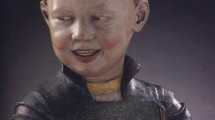Abstract
This paper explores the ‘mirthful face’ in Umberto Eco’s novel The Name of the Rose and Jean-Jacques Annaud’s film adaptation. Debates over the political and moral significance of the mirthful face are at the center of both texts’ interpretations of laughter and humor in medieval culture; but the novel’s withholding of facial description sits in stark contrast to the film’s embrace of contemporary perceptions of what ‘medieval faces’ would have looked like and how they might be read. Comparing Annaud’s visual language of ‘historical physiognomy’ with those of filmmakers Werner Hertzog and Michael Haneke, the essay situates both film and book within a late-twentieth-century use of the Middle Ages to comment on contemporary authoritarian and radical politics.




Similar content being viewed by others
References
Annaud, J.-J., dir. 1981. Quest for Fire (La guerre du feu). International Cinema Corporation.
Annaud, J.-J., dir. 1986. The Name of the Rose. Neue Constantin Film.
Annaud, J.-J. n.d. Le nom de la rose (1986). Jean-Jacques Annaud, http://jjannaud.com/les-films/le-nom-de-la-rose-1986/.
Bachmann, G. 1986. The Name of the Rose: Interview with Umberto Eco. Sight and Sound 55(2): 129–131.
Bayless, M. 1997. Parody in the Middle Ages: The Latin Tradition. Ann Arbor, MI: University of Michigan Press.
Capozzi, R. 1989. Palimpsests and Laughter: The Dialogical Pleasure of Unlimited Intertextuality in The Name of the Rose. Italica 66: 412–428.
Cavell, S. 1979. The World Viewed: Reflections on the Ontology of Film, enlarged ed. Cambridge, MA: Harvard University Press.
Comolli, J.-L. 1978. Historical Fiction: A Body Too Much, trans. Ben Brewster. Screen 19(2): 41–53.
Danes, J.A. 2011. The Critical Mythology of Irony. Athens, GA: University of Georgia Press.
D’Arcens, L. 2012. Dario Fo’s Mistero Buffo and the Left-Modernist Reclamation of Medieval Popular Culture. In Medieval Afterlives in Popular Culture, ed. G. Ashton and D. T. Kline, 57–70. New York: Palgrave Macmillan.
Doyle, A.C. 2014. A Study in Scarlet. A Sherlock Holmes Adventure. London: HarperCollins.
Eco, U. 1980. Il Nome della Rosa. Milan, Italy: Bompiani.
Eco, U. 1983. The Name of the Rose, trans. W. Weaver. London: Vintage Books.
Eco, U. 1984. Reflections on The Name of the Rose, trans. W. Weaver. London: Seeker & Warburg.
Fasolini, D. 2006. The Intrusion of Laughter into the Abbey of Umberto Eco’s The Name of the Rose: The Christian Paradox of Joy Mingling with Sorrow. Romance Notes 46: 119–129.
Fo, D. [1969] 1992. Mistero Buffo. In Plays: 1, trans. E. Emery, intro. S. Hood. London: Methuen.
Haneke, M., dir. 2009. The White Ribbon (Das Weiße Bande). X-filme Creative Pool, Wega Film, Les Films du Losange.
Herzog, W., dir. 1974. The Enigma of Kaspar Hauser (Jeder für sich und Gott gegen alle). Filmverlag der Autoren, Werner Herzog Filmproduktion.
Herzog, W., dir. 1976. Heart of Glass (Herz aus Glas). Werner Herzog Filmproduktion.
Klopp, C. 2005. Literature in Italy Since the Years of Lead. World Literature Today 79(3/4): 35–38.
Pasolini, P.P., dir. 1971. The Decameron (Il Decameron). Produzione Europee Associati, Les Productions Artistes Associés, Artemis Film.
Pasolini, P.P. 1972., dir. The Canterbury Tales (I Racconti di Canterbury). Les Productions Artistes Associés, Produzione Europee Associati.
Sanders, A. [1929] 2008. Face of Our Time (Antlitz der Zeit). Schirmer Visual Library.
Smith, D. 2010. Quality Control: An Interview with Michael Haneke. Reverse Shot, 10 January, http://reverseshot.org/interviews/entry/18/interview_michael_haneke.
Weeks, M.C. 2005. Milan Kundera: A Modern History of Humor amid the Comedy of History. Journal of Modern Literature 28(3): 131–148.
Acknowledgements
The research for this paper is supported by an Australian Research Council Future Fellowship for the Project ‘Comic Medievalism and the Modern World’ (FT120100931).
Author information
Authors and Affiliations
Corresponding author
Rights and permissions
About this article
Cite this article
D’Arcens, L. Mirthful faces in The Name of the Rose . Postmedieval 8, 51–66 (2017). https://doi.org/10.1057/s41280-016-0034-y
Published:
Issue Date:
DOI: https://doi.org/10.1057/s41280-016-0034-y




